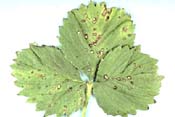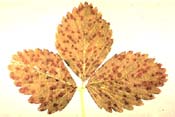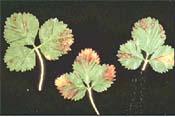Reports on Plant Diseases |
RPD No. 702 - Strawberry Leaf Diseases
|
September 1996
|
[ Symptoms ] [ Disease Cycle
] [ Control ] [ Disease Resistance Table
]
|
Three major leaf diseases can cause serious damage to strawberry plants
in Illinois: leaf spot, leaf scorch, and leaf blight. Strawberries (Fragaria
spp) are the only hosts of the pathogens causing these diseases. Depending
on the cultivar and climatic conditions, these diseases may occur singly
or together on the same plant - even on the same leaf. Damage to the plant
occurs as premature leaf death, reduction in yield and fruit quality,
and a general weakening that leads to reduced runner production, or rarely,
the plant death. These leaf diseases require control to maximize production.
Leaf spot and leaf scorch usually occur in early to mid-spring. Leaf
blight is more common during the summer and early fall.
|
Click
on image for larger version

Figure
1. Strawberry Leaf Spot
|
1. Leaf Spot
This disease (Figure 1) is caused by the fungus Mycosphaerella fragariae
(imperfect stage is Ramularia tulasnei). Leaf spot infects leaves, petioles,
runners, fruit stalks (pedicels), and berry caps or calyxes. Small, dark purple
to reddish-purple, round spots, 1/8 to 1/4 inch in diameter (3 to 6 millimeters),
appear on the upper leaf surfaces. The center of the spots soon become tan or
gray and eventually almost white, while the broad margins remain dark purple.
Later in the season, dark specks (sclerotia and/or perithecia) may be seen in
the older lesions. Indistinct, tan or bluish areas form on the underleaf surface.
The symptoms on the other plant parts, except the fruit, are almost identical
to those on the upper leaf surface. Only young, succulent plant parts are infected
by the leaf spot fungus.
In moist weather, superficial black spots about 1/4 inch (6 millimeters) in
diameter form on ripe berries. There is no general decay of an infected berry.
The spots surround groups of seeds (achenes) on the fruit surface. Usually,
only one or two spots occur on a berry; but some fruits may have as many as
eight or ten "black-seed."
2. Leaf Scorch
|
Click
on image for larger version

Figure
2. Strawberry
leaf scorch
|
The leaf scorch fungus, Diplocarpon earliana, attacks
the leaves, petioles, runners, pedicels, and calyxes of strawberry plants.
The fungus most frequently infects strawberry leaves at any stage of development.
The symptoms of leaf scorch (Figure 2) are very similar to the early stages
of leaf spot. Round to angular dark-purple spots, up to about 1/4 inch (6
millimeters) in diameter, are scattered over the upper leaf surface. As
the spots gradually enlarge, they resemble small drops of tar due to the
production of large numbers of minute, black, fungal fruiting bodies (acervuli).
|
The center of the spot remains dark purple, thus distinguishing this
disease from leaf spot. When numerous infections occur on a single leaf, the
leaf takes on a reddish or light purple color. Severely infected leaves dry
up and appear scorched. Similar but elongated spots may also appear on other
plant parts. Lesions may girdle the pedicels causing flowers and young fruits
to die. Infections on green berries are rare, appearing as red-to-brown discolorations
or a flecking of the fruit surface.
3. Leaf Blight
|
This disease is caused by the fungus Dendrophoma obscurans. Leaf
blight (Figure 3) is commonly found on plants after harvest. This disease
is distinctly different from leaf spot and leaf scorch. The enlarging
leaf spots are round to elliptical or angular and 1/4 inch to an inch
in diameter (6 to 25 millimeters). The spots are initially uniformly reddish-purple,
but soon develop a darker brown or reddish-brown center surrounded by
a light-brown area with a purple border. Similar spots sometimes develop
on the fruit calyx.
Normally, one to six lesions develop on a single leaflet. Frequently,
the infected area becomes V-shaped, with the widest part of the "V" at
the leaf margin. Small black dots, pycnidia of the causal fungus, appear
scattered over the center of older spots. New lesions appear throughout
the summer and fall when weather conditions are favorable. Older blighted
leaves may die in large numbers.
|
Click
on image for larger version

Figure
3. Strawberry leaf blight
|
Leaf blight is particularly destructive on slow-growing or weak plants. It
seldom damages young, runner plants. The same fungus rarely causes an enlarging,
soft, pale pink rot of the stem end of the fruit.
Back to Top
All three fungal pathogens overwinter in infected living or dead strawberry
leaf tissue.
-
The leaf spot fungus produces microscopic spores from three different
sources that infect new leaves in the spring. Firstly, older infected leaves
that remain alive during the winter give rise to conidia that are splashed
by water, or by handling wet infected plants, to the new foliage. The conidia
are produced in large numbers on clusters of short stalks (conidiophores)
that form over the entire underleaf surface.
Secondly, conidia can also be produced from black fungal structures (sclerotia)
that resist cold winter temperatures. These sclerotia form on dead strawberry
leaves. Thirdly, speck-sized black perithecia develop at the edges of the
leaf spots during the autumn months. Ascospores are produced within the
perithecia on these dead leaves during the winter. The ascospores are forcibly
ejected in the spring and are carried by wind or water to new leaf tissue.
Infection by both spore types occurs only through the lower leaf surface.
The incubation period between infection and the appearance of lesions on
the upper leaf surface is from 10 to 14 days. Large numbers of new conidia,
which appear as a downy white growth on the underleaf surface, are produced
and cause secondary infections during fairly prolonged periods of damp to
wet, moderately warm weather.
Temperatures between 65 and 75°F (18 to 24°C) are optimal for the growth
of the leaf spot fungus and lesion development. Infections continue to occur
throughout the growing season - except during hot, dry weather. Young, expanding
leaves are much more susceptible to infection than mature leaves. If frequent
rains occur during early- and mid-spring, a few infection sites can start
an epidemic.
-
The leaf scorch fungus also produces ascospores in the early spring,
within disk-shaped apothecia that appear as black dots in old lesions on
the lower surface of dead leaves. Conidia are also produced on both leaf
surfaces in glistening, speck-sized, black acervuli. These acervuli form
on diseased leaves that survive the winter.
Infection by the leaf scorch fungus, like the leaf spot pathogen, occurs
almost entirely through the lower leaf surface. In the presence of moisture,
ascospores germinate and infect within 24 hours. The incubation period between
infection and the appearance of lesions with conidia is 14 days. Conidia
are produced in large numbers throughout the growing season, so that repeated
secondary infections occur whenever weather conditions are favorable. The
conidia are disseminated primarily by splashing water and to a much lesser
extent by insects, birds, and by handling wet plants.
- The leaf blight fungus produces only conidia in speck-sized, black
pycnidia which are embedded in the centers of older lesions. The conidia ooze
from the pycnidia during damp weather when the temperatures are warm to hot.
The spores are splashed by water to new leaf tissue, where they germinate
in the presence of free water and initiate new infections on the leaves and
fruit caps.
The spread of all these leaf-infecting fungi is favored by frequent rains,
overhead irrigation, and heavy dews. There is little spread during hot, dry
weather in the summer, although the symptoms of leaf blight may continue to
develop during this period.
A rapid buildup of all three leaf diseases occurs in autumn during rainy periods
or when overhead irrigations are frequent after renovation. The buildup of
leaf diseases can seriously weaken strawberry plants and can provide large
amounts of inoculum that may result in heavy infections the following spring.
Back to Top
Leaf diseases of strawberries are effectively controlled when the practices
outlined below are followed.
-
Choose disease resistant cultivars adapted to your
location. The table at the end of the page lists the disease reactions
to leaf spot and leaf scorch of 22 strawberry cultivars commonly grown in
Illinois. This table can be used only as a guide for selecting cultivars,
since it represents average disease reactions. Due to the presence
of different races of the pathogens, strawberry cultivars rated as resistant
in one location may be susceptible in another.
-
Start with certified, disease-free plants purchased from a reputable
nursery.
-
These cultural practices help reduce infections.
-
Plant in full sunlight in well-drained soil with good air circulation.
-
Prevent weed growth by cultural or chemical methods.
-
Take care in spacing runner plants in matted-row culture. Do not allow
an over-population of plants.
-
Always remove the old infected leaves from runner plants before setting.
-
Apply nitrogen fertilizers only at renovation time. Applications
of nitrogen in the spring produce an overabundance of young leaf tissue
susceptible to leaf-disease fungi.
-
Follow a fungicide spray schedule recommended for the control of leaf diseases
and fruit rots. Home fruit growers should follow the spray program for strawberries
in the current Illinois Extension Circular 1145 "Home Fruit Pest
Control". Commercial strawberry growers should consult the most recent copy
of the Illinois Extension Circular Md-1, Illinois Commercial Small fruit
and Grape Spray Guide. The first spray should be made in the spring
just before the first blossoms open. For June-bearing cultivars, repeat
the fungicide applications at 7- to 10-day intervals through to final harvest.
An additional fungicide application should be made on June-bearing cultivars
a week or two after renovation. Spray ever bearing cultivars at 7- to 10-day
intervals during the primary fruiting periods. The spray intervals can be
lengthened to two or three weeks for the remainder of the season.
Thoroughly cover all above-ground plant parts with each spray. Since the
leaf spot and leaf scorch pathogens infect only through the underleaf surface,
the undersides must be well sprayed with fungicide. Sprays give more effective
and longer-lasting protection than dusts. It helps to apply fungicides when
the air is calm and the plants are damp from rain or dew. Always consult
a current fungicide label for directions and restrictions on use before
application, and follow the instructions given carefully.
- In seriously infected plantings, mow, rake, and destroy (burn) all diseased
strawberry debris at renovation time immediately after harvest. In such
plantings, fungicides should be applied immediately after renovation and at
2- to 3-week intervals until new foliar growth ceases in the fall (see No.
5, above).
For more details concerning suggested cultural management practices, including
fertilization, those who grow strawberries at home should consult Illinois
Extension Circular 935, Growing Small Fruits in the Home Garden. Copies
of Circular 935 are available at your nearest Extension office or from
the Office of Agricultural Publications, 54 Mumford Hall, 1301 West Gregory
Drive, Urbana, Illinois 61801. Commercial growers should check the most recent
Proceedings of the Illinois Small Fruit and Strawberry Schools. Copies
of the proceedings can be obtained by writing to Jeff Kindhart, Dixon Springs
Agricultural Center, Simpson, Illinois 62985.
Back to Top
Disease Resistance of Strawberry Cultivars Commonly Grown
in Illinois
|
a VS = very susceptible;
S = susceptible; I = intermediate; T = tolerant;
R = resistant; VR = very resistant; - = unknown.
Resistant characteristics of the cultivar usually preclude the need for
other controls.
b Resistant to several races of the red stele
fungus.
|
| Cultivar |
Red stele |
Verticillium wilt |
Leaf spot |
Leaf scorch |
Powdery mildew |
| Allstar |
VRa |
R |
R |
R |
R |
| Canoga |
I |
I |
R |
R |
- |
| Cardinal |
S |
S |
R |
R |
R |
| Catskill |
S |
VR |
S |
R |
R |
| Delite |
Rb |
R |
R |
S-R |
S |
| Earliglow |
Rb |
T-R |
S-R |
R |
I |
| Guardian |
Rb |
T-R |
S-R |
R |
S-R |
| Honeoye |
S |
S |
R |
R |
- |
| Jewel |
S |
S |
R |
R |
- |
| Lester |
R |
R |
R |
R |
R |
| Midway |
Rb |
S-I |
S |
S |
I |
| Pocahontas |
S |
S |
S-R |
S-I |
R |
| Raritan |
S |
S |
S |
S |
S |
| Redchief |
Rb |
R |
S-R |
R |
S-R |
| Scott |
R |
9-R |
S-R |
R |
R |
| Sparkle |
S-R |
S |
S |
S-I |
R |
| Sunrise |
Rb |
R |
VS |
R |
R |
| Surecrop |
Rb |
VR |
S-R |
S-R |
- |
| Tennessee Beauty |
S |
R |
R |
S-R |
S |
| Ever Bearing |
| Tribute |
VR |
T-R |
T |
T |
R |
| Tristar |
R |
R |
T |
T |
R |
|
a VS = very susceptible;
S = susceptible; I = intermediate; T = tolerant;
R = resistant; VR = very resistant; - = unknown.
Resistant characteristics of the cultivar usually preclude the need for
other controls.
b Resistant to several
races of the red stele fungus.
|
Back to Top
Author:
Stephen M. Ries (s-ries@uiuc.edu]
|



